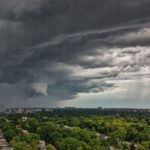How tornado frequency and severity is trending in Canada
Tornado frequency more than doubled nationwide over the past decade compared to the previous 10-year period, finds a new study from My Choice Financial, Inc.
And Ontario tops the charts when it comes to these weather phenomena, the study says.
Most recently, on June 20, a tornado touched down north of London, Ont. Strong thunderstorms moving through southern Ontario that day produced a short-lived EF0 tornado near the community of Lucan, The Weather Network reported. The Enhanced Fujita (EF) scale assess storm severity. Some minor damage occurred, including broken branches, downed trees and crop damage.
On May 26, back-to-back EF1 tornadoes tore through Alberta’s Lac La Biche region northeast of Edmonton, peeling the roof off a home near Atmore and snapping trees along two narrow damage paths that stretched up to 21 kilometres, Insurtech MyChoice says in a press release last month.
“While no injuries were reported, the early season twisters serve as a vivid reminder that Canada’s tornado threat is intensifying and shifting toward more populated areas,” it adds.
To better understand the dynamics of tornadoes across Canada, MyChoice conducted an in-depth study to identify which parts of the country face an increased risk in 2025. The insurtech tapped into Western University’s Northern Tornadoes Project (NTP). Using the project’s advanced national dashboard, MyChoice pulled two equal ten-year slices of data (2005-2014 and 2015-2024) and:
- tallied every confirmed event by Enhanced Fujita rating (EF0-EF5)
- broke those counts down by province to spotlight regional shifts
- zeroed in on the EF2-and-stronger subset, which is least sensitive to improvements in tornado detection over time.
Frequency, severity ticks up
The study found tornado frequency more than doubled nationwide. Canada now averages 88 tornadoes per year, up from 41 in the prior decade — an overall 114% increase. It also found EF2-plus events — those with wind speeds between 180 km/h and 220 km/h — increased by 123%, “underscoring that the uptick is not just limited to weak landspouts.”
By province, the study found Ontario leads with 347 events from 2015 to 2024 (up from 221 in the prior decade), and its EF2 strikes have almost doubled to 69, “meaning damaging, roof-lifting storms are becoming an annual reality.”
Quebec saw the steepest climb, jumping to 206 tornadoes (from 68) as EF2 counts exploded from 11 to 52, a surge that shifts the province firmly into the ‘significant storm’ category, MyChoice says.
Alberta logged 109 tornadoes, up 51%. While EF2s slipped slightly (from 12 to 9), the province notched its first EF4 in 2023.
Manitoba edged up to 76 tornadoes and boosted its EF2 tally from 6 to 9, plus an additional EF4.
And Saskatchewan recorded a slight dip to 125 tornadoes, yet EF2 twisters leapt from 9 to 14.
From an insurance perspective, when it comes to tornadoes, most Canadian home insurance policies cover windstorm losses, such as roof and siding repairs, blown-in rain, and debris cleanup, MyChoice notes. Comprehensive auto coverage also handles hail-damaged vehicles.
“What catches many homeowners off guard is the wind/hail deductible (often $ 2,500 or more) and rebuild limits that haven’t kept pace with construction costs,” the release says.
“Tornado damage is covered more often than people think, but only if you’ve got the right limits and you understand your deductible,” says MyChoice chief operations officer Matthew Roberts.
MyChoice recommends the following preparation measures:
- Make sure the policy includes Guaranteed Replacement Cost
- Check sub-limits for outbuildings and landscaping
- Maintain an up-to-date digital inventory of possessions, and be aware additional living expense coverage can fund hotels if your home is uninhabitable
- ‘Harden’ the property by anchoring patio furniture, trimming dead branches and storing an emergency kit.
